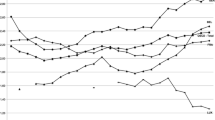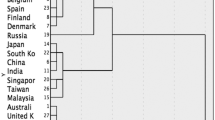Abstract
This paper investigates the dynamic evolution profiles of science and technology knowledge production in Brazil and the Republic of Korea from 2000 to 2009. The two countries have followed different models of publication profiles, bioenvironmental model and Japanese model, and they currently belong to periphery countries in terms of the center-periphery framework. Brazil and the Republic of Korea have established a few core disciplines successfully and increased their share in the world publication of scientific papers over the last decade. Notwithstanding the fact that the two countries have recorded sustained growth in the percentage of published scientific papers, South Korea has evolved into a more balanced science and technology knowledge production system, whereas Brazil into the more unbalanced knowledge production system. Core-lagging or periphery-lagging patterns of science production have been revealed in Brazil and indirectly imply that the existing science base has not been fully stimulated or utilized.








Similar content being viewed by others
Notes
Refer to “Data and research methods” section for the definitions of RCAP and RCAC.
For examples of bibliometric methods applied in the evaluation of science-based programs, see http://www.science-metrix.com/.
Table 4 contains only 17 fields of science because two small fields, psychology and immunology, are omitted for the sake of simplicity.
References
Albuquerque, E. D. M. (2001). Scientific infrastructure and catching-up process: Notes about a relationship illustrated by science and technology statistics. Revista brasileira de economia, 55(4), 545–566.
Balassa, B. (1977). ‘Revealed’ comparative advantage revisited: An analysis of relative export shares of the industrial countries, 1953–1971. The Manchester School, 45(4), 327–344.
Bound, K. (2008). Brazil, the natural knowledge economy. London: Demos.
Choung, J.-Y., & Hwang, H.-R. (2013). The evolutionary patterns of knowledge production in Korea. Scientometrics, 94(2), 629–650.
Chuang, Y. W., Lee, L. C., Hung, W. C., & Lin, P. H. (2010). Forging into the innovation lead—A comparative analysis of scientific capacity. International Journal of Innovation Management, 14(03), 511–529.
Fink, D., Hameed, T., So, M., Kwon, Y., & Rho, J. J. (2012). S&T collaboration in developing countries: Lessons from Brazilian collaboration activities with South Korea. STI Policy Review, 3, 92–110.
Gaillard, J. (2010). Measuring research and development in developing countries: Main characteristics and implications for the Frascati Manual. Science Technology & Society, 15(1), 77–111.
Glänzel, W., Debackere, K., & Meyer, M. (2008). ‘Triad’or ‘tetrad’? On global changes in a dynamic world. Scientometrics, 74(1), 71–88.
Glänzel, W., Leta, J., & Thijs, B. (2006). Science in Brazil. Part 1: A macro-level comparative study. Scientometrics, 67(1), 67–86.
Glänzel, W., & Schubert, A. (2005). Analysing scientific networks through co-authorship. In H. F. Moed, W. Glänzel, & U. Schmoch (Eds.), Handbook of quantitative science and technology research (pp. 257–276). Dordrecht, The Netherlands: Kluwer Academic Publishers.
Glänzel, W., Thijs, B., Schubert, A., & Debackere, K. (2009). Subfield-specific normalized relative indicators and a new generation of relational charts: Methodological foundations illustrated on the assessment of institutional research performance. Scientometrics, 78(1), 165–188.
Hu, X., & Rousseau, R. (2009). A comparative study of the difference in research performance in biomedical fields among selected Western and Asian countries. Scientometrics, 81(2), 475–491.
Hwang, K. (2008). International collaboration in multilayered center-periphery in the globalization of science and technology. Science, Technology and Human Values, 33(1), 101–133.
Kim, M. J. (2005). Korean science and international collaboration, 1995–2000. Scientometrics, 63(2), 321–339.
Kwon, K. S. (2011). The co-evolution of universities’ academic research and knowledge-transfer activities: the case of South Korea. Science and Public Policy, 38(6), 493–503.
Larivière, V. (2010). A bibliometric analysis of Quebec’s PhD students’ contribution to the advancement of knowledge. Doctoral dissertation, McGill University
Lattimore, R., & Revesz, J. (1996). Australian science: Performance from published papers. Australian Government Pub. Service. http://www.pc.gov.au/bureau-industry-economics/report/96-03. Accessed 15 October 2012.
Leta, J., Glänzel, W., & Thijs, B. (2006). Science in Brazil. Part 2: Sectoral and institutional research profiles. Scientometrics, 67(1), 87–105.
Nagpaul, P. S. (2003). Exploring a pseudo-regression model of transnational cooperation in science. Scientometrics, 56(3), 403–416.
Schubert, A., & Braun, T. (1986). Relative indicators and relational charts for comparative assessment of publication output and citation impact. Scientometrics, 9(5), 281–291.
Schulz, P. A., & Manganote, E. J. (2012). Revisiting country research profiles: learning about the scientific cultures. Scientometrics, 1–15.
Widgrén, M. (2005). Revealed comparative advantage in the Internal Market (No. 989). ETLA Discussion Papers. The Research Institute of the Finnish Economy (ETLA). http://hdl.handle.net/10419/63731 Accessed 2 November 2012.
Yi, Y., Qi, W., & Wu, D. (2013). Are CIVETS the next BRICs? A comparative analysis from scientometrics perspective. Scientometrics, 94(2), 615–628.
Zelnio, R. (2012). Identifying the global core-periphery structure of science. Scientometrics, 91(2), 601–615.
Zhou, P., Thijs, B., & Glänzel, W. (2009). Regional analysis on Chinese scientific output. Scientometrics, 81(3), 839–857.
Zitt, M., & Bassecoulard, E. (2008). Challenges for scientometric indicators: Data demining, knowledge-flow measurements and diversity issues. Ethics in science and environmental politics, 8(5–7), 49–60.
Zitt, M., Bassecoulard, E., & Okubo, Y. (2000). Shadows of the past in international cooperation: Collaboration profiles of the top five producers of science. Scientometrics, 47(3), 627–657.
Author information
Authors and Affiliations
Corresponding author
Appendix
Appendix
NSI fields and abbreviations
Abbreviation | Field | Abbreviation | Field |
|---|---|---|---|
AGRI | Agricultural sciences | MAT | Mathematics |
BIO | Biology and biochemistry | MIC | Microbiology |
CHE | Chemistry | MOL | Molecular biology and genetics |
MED | Clinical medicine | NEU | Neuroscience and behavior |
CS | Computer science | PHA | Pharmacology and toxicology |
ENG | Engineering | PHY | Physics |
ENV | Environment/ecology | ANI | Plant and animal science |
GEO | Geosciences | PSY | Psychiatry/psychology |
IMM | Immunology | SPA | Space science |
MS | Materials science |
Rights and permissions
About this article
Cite this article
Fink, D., Kwon, Y., Rho, J.J. et al. S&T knowledge production from 2000 to 2009 in two periphery countries: Brazil and South Korea. Scientometrics 99, 37–54 (2014). https://doi.org/10.1007/s11192-013-1085-6
Received:
Published:
Issue Date:
DOI: https://doi.org/10.1007/s11192-013-1085-6




